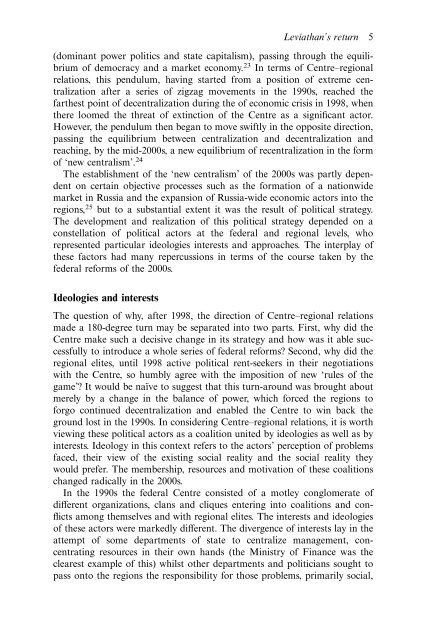Federalism and Local Politics in Russia
Federalism and Local Politics in Russia
Federalism and Local Politics in Russia
You also want an ePaper? Increase the reach of your titles
YUMPU automatically turns print PDFs into web optimized ePapers that Google loves.
Leviathan’s return 5(dom<strong>in</strong>ant power politics <strong>and</strong> state capitalism), pass<strong>in</strong>g through the equilibriumof democracy <strong>and</strong> a market economy. 23 In terms of Centre–regionalrelations, this pendulum, hav<strong>in</strong>g started from a position of extreme centralizationafter a series of zigzag movements <strong>in</strong> the 1990s, reached thefarthest po<strong>in</strong>t of decentralization dur<strong>in</strong>g the of economic crisis <strong>in</strong> 1998, whenthere loomed the threat of ext<strong>in</strong>ction of the Centre as a significant actor.However, the pendulum then began to move swiftly <strong>in</strong> the opposite direction,pass<strong>in</strong>g the equilibrium between centralization <strong>and</strong> decentralization <strong>and</strong>reach<strong>in</strong>g, by the mid-2000s, a new equilibrium of recentralization <strong>in</strong> the formof ‘new centralism’. 24The establishment of the ‘new centralism’ of the 2000s was partly dependenton certa<strong>in</strong> objective processes such as the formation of a nationwidemarket <strong>in</strong> <strong>Russia</strong> <strong>and</strong> the expansion of <strong>Russia</strong>-wide economic actors <strong>in</strong>to theregions, 25 but to a substantial extent it was the result of political strategy.The development <strong>and</strong> realization of this political strategy depended on aconstellation of political actors at the federal <strong>and</strong> regional levels, whorepresented particular ideologies <strong>in</strong>terests <strong>and</strong> approaches. The <strong>in</strong>terplay ofthese factors had many repercussions <strong>in</strong> terms of the course taken by thefederal reforms of the 2000s.Ideologies <strong>and</strong> <strong>in</strong>terestsThe question of why, after 1998, the direction of Centre–regional relationsmade a 180-degree turn may be separated <strong>in</strong>to two parts. First, why did theCentre make such a decisive change <strong>in</strong> its strategy <strong>and</strong> how was it able successfullyto <strong>in</strong>troduce a whole series of federal reforms? Second, why did theregional elites, until 1998 active political rent-seekers <strong>in</strong> their negotiationswith the Centre, so humbly agree with the imposition of new ‘rules of thegame’? It would be naïve to suggest that this turn-around was brought aboutmerely by a change <strong>in</strong> the balance of power, which forced the regions toforgo cont<strong>in</strong>ued decentralization <strong>and</strong> enabled the Centre to w<strong>in</strong> back theground lost <strong>in</strong> the 1990s. In consider<strong>in</strong>g Centre–regional relations, it is worthview<strong>in</strong>g these political actors as a coalition united by ideologies as well as by<strong>in</strong>terests. Ideology <strong>in</strong> this context refers to the actors’ perception of problemsfaced, their view of the exist<strong>in</strong>g social reality <strong>and</strong> the social reality theywould prefer. The membership, resources <strong>and</strong> motivation of these coalitionschanged radically <strong>in</strong> the 2000s.In the 1990s the federal Centre consisted of a motley conglomerate ofdifferent organizations, clans <strong>and</strong> cliques enter<strong>in</strong>g <strong>in</strong>to coalitions <strong>and</strong> conflictsamong themselves <strong>and</strong> with regional elites. The <strong>in</strong>terests <strong>and</strong> ideologiesof these actors were markedly different. The divergence of <strong>in</strong>terests lay <strong>in</strong> theattempt of some departments of state to centralize management, concentrat<strong>in</strong>gresources <strong>in</strong> their own h<strong>and</strong>s (the M<strong>in</strong>istry of F<strong>in</strong>ance was theclearest example of this) whilst other departments <strong>and</strong> politicians sought topass onto the regions the responsibility for those problems, primarily social,
















